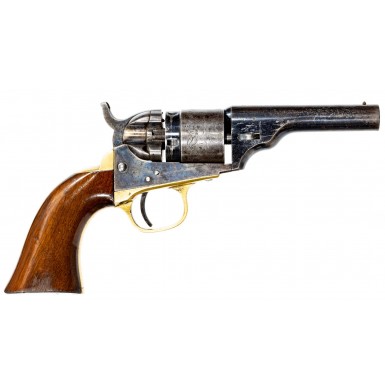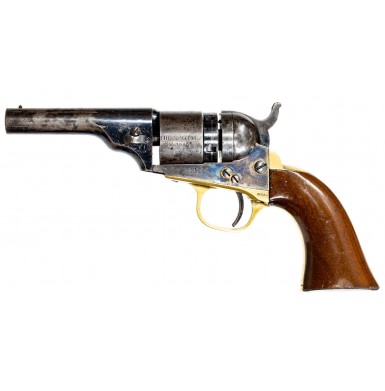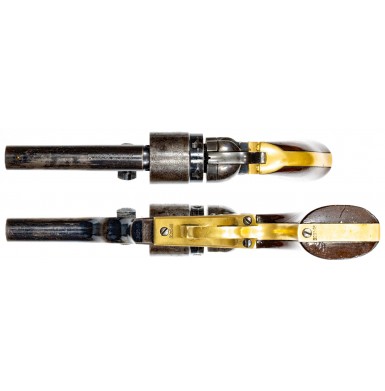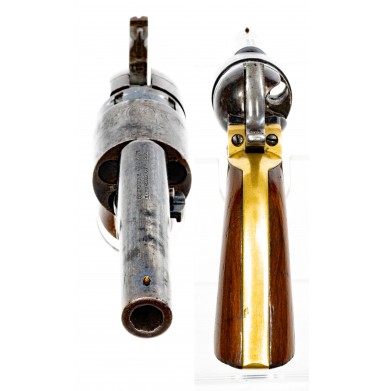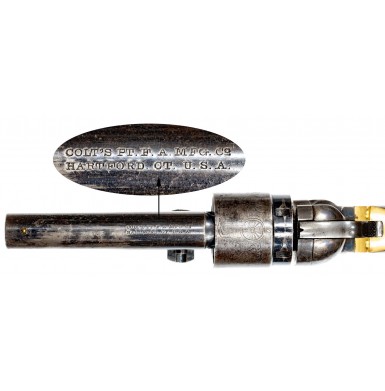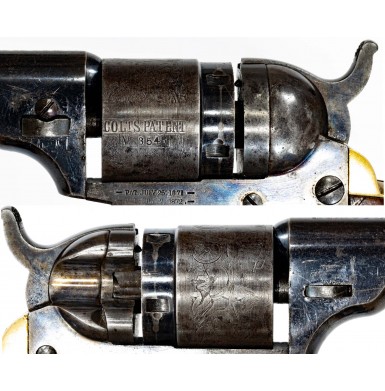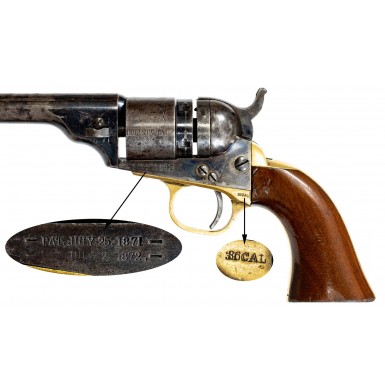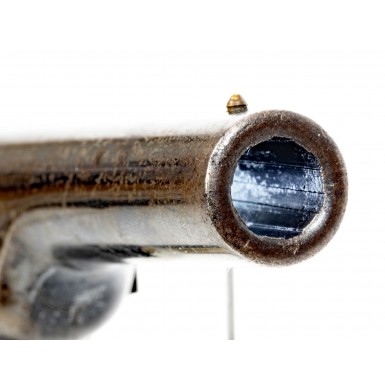Colt Round Barrel Cartridge Revolver - Fine
- Product Code: FHG-2236-SOLD
- Availability: Out Of Stock
-
$1.00
At the close of the American Civil War the Colt Patent Firearms Company was aware of two facts that would greatly impact their business for the next decade. First, the end of war not only meant no more major US military orders for handguns in the foreseeable future, it also meant that thousands of surplus US military percussion revolvers would soon be flooding the market, making newly made percussion revolvers difficult (if not impossible) to sell. Second, the day of the percussion revolver was over, and the new self-contained cartridge handgun was the wave of the future.
Unfortunately for Colt, Smith & Wesson held the exclusive rights to Rollin White’s patent on the bored-through cylinder, which meant that until that patent expired in 1869 there was no easy way for Colt to manufacture a traditional cartridge revolver without infringing upon that patent. Colt also had thousands of parts on hand to produce the many models of percussion handguns that had been its bread and butter business since the firm was founded. Immediately the designers were put to work to find reasonable ways to manufacture cartridge handguns from the parts on hand, as well as how to convert existing percussion revolvers to cartridge handguns. Although the possibilities for both production and conversion were somewhat limited until the expiration of White’s patent, the designs patented by F. Alexander Thuer in 1868 and 1870 allowed Colt to offer Thuer conversions of all the popular percussion models as an interim product line, until bored through cylinders could be used.
The Thuer system was not particularly successful and only about 5,000 Thuer altered revolvers of all models were produced. It is interesting to note that the first of the Colt “bored through cylinder” cartridge revolvers to be offered after the expiration of White’s patent were not alterations of existing models, but were two completely new product lines, the .22RF Colt Open Top revolvers and Colt Cloverleaf Pocket Revolvers. Following their introduction Colt started to produce the Richards and Richards Mason conversions of their larger framed revolvers, including the Model 1860 Army and the Models 1851 and 1861 “Navy” revolvers. These were produced both as newly made guns, using percussion revolver parts on hand, as well as true conversions of previously manufactured percussion revolvers. In total about 9,000 M1860 Army Richards conversions were produced, with an additional 2,100 Richards-Mason Army models manufactured. About 3,800 M1851 Navy revolvers were altered to .38 caliber (both rimfire and centerfire) and another 2,200 M1861 Navy revolvers were so altered.
The single largest batch of altered, converted or remanufactured revolvers were in the 1862 Police and Pocket Navy sizes, all altered to .38 caliber, both rimfire and centerfire. Colt produced 24,000 cartridge revolvers on this mid-sized frame between 1873 and 1881, with a wide variety of models (at least 5) and configurations. For the ease of identifying these guns for modern collectors, the guns have essentially been divided into categories based upon their barrel profile; octagonal or round, as well as by barrel lengths and the presence or absence of an ejector system. In some cases, the guns were made almost completely from left over percussion parts on hand. Sometimes the guns were alterations of completed percussion guns left in inventory and sometimes they were a hybrid of old and newly made parts. To make matters more confusing the presence or absence of features like loading gates and barrel addresses almost appear to be random on some “models”, and to further muddy the waters, these mid-sized .38 cartridge revolvers were produced in 3 different serial number ranges!
The guns are found serial numbered in the upper regions of the Model 1849 Pocket serial number range (between about 274,000 and 328,000), in the upper regions of the Model 1862 Pocket Navy and Police ranges (found between about 36,000 and 48,000) and in their own range of 1-19,000. The guns were manufactured between 1873 and 1880/81 with most of the new serial number range guns manufactured between 1873-1875, and the balance of the guns primarily being produced c1875-1880. In all cases, the unsold stock remained on hand and in many cases was still shipping well into the mid-to-late 1880s.
Offered here is a FINE condition example of what collectors refer to as the 3 ½” Round (Cartridge) Barrel Model. Like all of the other similar .38 cartridge guns that Colt produced during this era, the revolver was based upon the frame of the 1862 Pocket Navy/Police series and the 5-shot rebated cylinder of the 1862 Pocket Navy. The barrels for these guns were newly made, 3 ½” long and as the name implies had a round profile. The guns were manufactured from about 1873 through 1880, with about 6,000 being produced during that time. Roughly half of the production was in .38 rimfire and the other half was in .38 centerfire (.38 Colt). This is one of the more desirable centerfire revolvers chambered for the .38 Colt cartridge. According to R.L. Wilson’s analysis of the Colt Company ledgers, the majority of the guns were apparently produced in 1876 and 1877, and those with 6 digit serial numbers at the end of the M1849 Pocket range are typically centerfire guns, while those made in the 1862 Pocket Navy/Police range were typically rimfire. The guns were made without an ejector rod, and most did not have a loading gate. With the short barrel, and lack of ejector, the guns were probably the very first Colt cartridge revolvers that could be termed “sheriff’s models”.
This example is numbered at the end of the M1849 Pocket range, and the matching number 323548 is found on the bottom of the grip, on the triggerguard, on the bottom of the frame and on the bottom of barrel web. The cylinder is numbered wit the last 4 digits, 3548 and these same 4 digits are neatly written in ink, in a period hand, in the backstrap cut out of the grip. The wedge is an unnumbered one that was made at the time the gun was manufactured and is clearly original to the revolver. The rebated cylinder is clearly marked COLT’S PATENT over the serial number and retains about 80% of its original “stagecoach hold up” roll engraved scene. The left side of the frame is clearly stamped in two lines: - PAT. JULY. 25, 1871 - over - PAT. JULY. 2, 1872 - . The left rear of the triggerguard web is deeply stamped .36 CAL. and is clearly double struck. While most of the round barrels are unmarked, this one has a two-line address that reads:
COLT’S PT. F.A. MFG. Co
HARTFORD, CT U.S.A.
As previously noted, the revolver is in about FINE condition. The frame retains about 50%+ of its original Colt factory case hardened finish. The finish is the typically deeper and darker color found on Colt cartridge conversion era revolvers. The frame shows some vivid colors and mottling with traces of the original striking blues and purples visible, primarily on the left side. The frame has dulled to a mostly mottled gray appearance with faded color that shows splashes of color here and there. The frame is free of any pitting but does show a couple of small flecks of light surface oxidation. The hammer retains about 70%+ of its vivid case coloring with some fading and dulling, leaving traces of a silvery-gray patina in the finish and along the sharp edges where the finish has worn and been handled. The cylinder retains about 10%+ original blued finish, most of which is in the rebated portion of the cylinder. The balance of the cylinder shows lightly oxidized brownish patina with minute flecks of blue here and there. The cylinder scene remains extremely sharp and clear and is at least 80% present. The brass backstrap, gripstrap and triggerguard retain none of their original silver plating on the exposed surfaces and have a lovely medium golden patina. The 3 ½” round barrel retains about 50%+ of its original blued finish which is strongest on the bottom and the right side, and weakest nearer the muzzle on left side where a thumb-sized area has been cleaned. The right side of the web shows a handful of minor impact marks as a result of the wedge being driven out of the revolver many times, and the web area shows some minor surface scratching on both sides from handling and use. The balance of the barrel where the finish has been lost has a sort of mottled, dull smoky bluish-gray patina, combing the original thinning blue and gray age patina of the metal. The barrel is free of any real pitting, but does show some areas of light pinpricking, most around the web, forward of the chamber mouths and some scattered tiny patches of light surface oxidation along its length. The bore of the revolver is in VERY GOOD+ condition and remains mostly bright with sharp rifling its entire length. The bore shows some scattered oxidation and light pitting with a couple of patches of more moderate pitting here and there. The original brass cone shaped front sight is in place on the top of the barrel near the muzzle and the sighting notch in the hammer nose remains crisp and sharp. The gun is mechanically excellent and indexes, times, and locks up perfectly, with the hammer responding crisply to the trigger. The screws are all original and are in very good condition, all retaining at least some finish and all only a couple of them showing any significant slot wear. The varnished one-piece grip is in about FINE condition as well, and as previously mentioned is numbered to the gun. The grip retains about 80%+ of its original varnish and is free of any breaks, cracks, chips or repairs. The majority of the varnish loss is on the bottom part of the lower edges, likely from carry wear in a pocket, and along the high edges around the grip base. The grip does show some scuffs and handling marks, as well as some minor rounding to the sharp edges along the lower edge but is really in very nice and crisp condition.
Overall this is a really very nice example of a Colt Round Barrel Cartridge Revolver. These little guns were made in a relatively small quantity of about 6,000, during the height of American’s westward expansion push in the two-decades following the American Civil War. As they were cheaper than the larger Richards and Richards-Mason guns and could easily be carried in a pocket, most do not survive in this very nice state of preservation. When one of these revolvers is found with this much finish it is almost always a nickel plated gun and not a blued one. This would be a fantastic addition to any advanced collection Colt revolvers or old west arms and would be rather difficult to upgrade from without spending significantly more money. Although this one is really much too nice to shoot, it would no doubt be a wonderful old west pocket or hide out revolver for an authentic Cowboy Action Shooting side match. This is a lovely little Colt revolver that you will be very pleased to add to your collection.
SOLD


